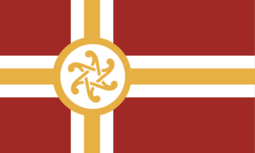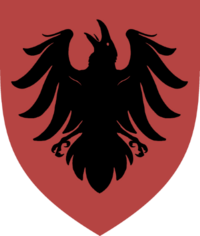Flag of Cuirpthe: Difference between revisions
(intro rewritten) |
No edit summary |
||
| Line 15: | Line 15: | ||
| Design2 = A red field with a white and gold cross shifted to the hoist side. | | Design2 = A red field with a white and gold cross shifted to the hoist side. | ||
}} | }} | ||
The '''flag of Cuirpthe''' ([[Cuirpthean language|Cuirpthean]]: '' | The '''flag of Cuirpthe''' ([[Cuirpthean language|Cuirpthean]]: ''Bratach in Chuirpeidh'') consists of a crimson field with a white and gold asymmetrical horizontal cross, with the crossbar closer to the hoist than the fly, with the cross extending to the edge of the flag. Where the cross intersects is a charge displaying two interlocking gold triskeles at the center of a gold circle. The flag was first adopted as the {{wpl|national flag}} of modern [[Cuirpthe]] in 1900, following the conclusion of the [[Great War (Aeia)|Great War]]. | ||
Prior to the Great War, Cuirpthe had maintained a horizontal {{wpl|tricolor}} flag since the [[Kingdom of Cuirpthe]]'s foundation in 1784. Red, white and gold were the colors of the 1712 revolution, one of several uprisings by the Cuirpthean people against the [[Commonwealth of Cuirpthe-Newrey]] during the [[Mydro-Commonwealth Wars]]. In 1722, a red, white and gold tricolor with the coat of arms of [[Midrasia|Midrasian]] Cuirpthe was adopted as the flag. In 1784, the coat of arms was removed to symbolize Cuirpthe's freedom from Midrasia. | Prior to the Great War, Cuirpthe had maintained a horizontal {{wpl|tricolor}} flag since the [[Kingdom of Cuirpthe]]'s foundation in 1784. Red, white and gold were the colors of the 1712 revolution, one of several uprisings by the Cuirpthean people against the [[Commonwealth of Cuirpthe-Newrey]] during the [[Mydro-Commonwealth Wars]]. In 1722, a red, white and gold tricolor with the coat of arms of [[Midrasia|Midrasian]] Cuirpthe was adopted as the flag. In 1784, the coat of arms was removed to symbolize Cuirpthe's freedom from Midrasia. | ||
The double triskelion symbol first appeared in 1832, on the naval jack and ensign of the Royal Navy. The symbol was derived from ancient pagan tradition, and had been a popular symbol of Cuirpthean nationalism during the Commonwealth and Midrasian periods. The symbol would be incorporated into the national flag following the collapse of the throne. The tricolor continued to be used as a symbol of the radical right | The double triskelion symbol first appeared in 1832, on the naval jack and ensign of the Royal Navy. The symbol was derived from ancient pagan tradition, and had been a popular symbol of Cuirpthean nationalism during the Commonwealth and Midrasian periods. The symbol would be incorporated into the national flag following the collapse of the throne. The tricolor continued to be used as a symbol of the state, but also adopted as a symbol of the radical right (particularlym supporters of [[Maíreidh Unionism]]). In some cases, the radical left have also made use of the design, who repurposed the tricolor (with the addition of communist symbolism) for the flag of the [[Cuirpthean People's State]]. | ||
The current national flag is officially protected under the current Cuirpthean constitution from all acts of defamation and vandalism. Consequences of these acts, as defined by §90 of the Pioncód, are fines and prison sentences of up to 5 years. | The current national flag is officially protected under the current Cuirpthean constitution from all acts of defamation and vandalism. Consequences of these acts, as defined by §90 of the Pioncód, are fines and prison sentences of up to 5 years. | ||
==Origins== | |||
The Cuirpthean association with the colors red, gold and white originally appeared in the early 18th century, where the three colors were used to symbolize Cuirpthean nationalism during the last years of the Commonwealth. Following the Commonwealth's partition, the colors were officially adopted in the 1722 flag. | |||
There are multiple theories concerning the exact origin of the color scheme. One theory proposes that the colors were originally associated with the (tba) Student's League (''tba''), one of the most prominent reactionary groups in Commonwealth controlled Cuirpthe that advocated for Cuirpthean independence; their official coat of arms used the three colors. Others attribute it to the uniforms (red with white trim and gold buttons) of the Free Cuirpthean Army, the military formed by rebels during the Mydro-Commonwealth Wars. Whatever the actual origin, these colors became recognized as the official colors of Cuirpthe, and were in some way incorporated into every subsequent flag of the nation. | |||
==Flag variants== | |||
{{further|List of Cuirpthean flags}} | |||
===Civil Flag=== | |||
The Cuirpthean {{wpl|national flag}} was introduced in 1900, as part of the Cuirpthean constitution written following the conclusion of the Great War. Following the creation of separate military flags in the 1910s, a new flag was adopted in 1922 was adopted, acting as a {{wpl|civil flag}} and {{wpl|civil ensign}}. This flag is identical to the state flag, but only features the gold and white cross shifted to hoist, without the interlinked triskelions. Non-government authorities usually fly this flag to show connection to the government, such as provincial governments flying it alongside their own flags. | |||
===Vertical Flags=== | |||
===Military flags=== | |||
==Design== | |||
==Flag days== | |||
==History== | ==History== | ||
Revision as of 00:50, 28 April 2019
 | |
| Use | State flag |
|---|---|
| Proportion | 3:5 |
| Adopted | 1900 |
| Design | A red field with a white and gold cross shifted to the hoist side. The cross is charged with interlocking golden triskelions. |
| File:CuirptheCivil.png Variant flag of Cuirpthe | |
| Use | Civil flag and ensign |
| Proportion | 3:5 |
| Adopted | 1922 |
| Design | A red field with a white and gold cross shifted to the hoist side. |
The flag of Cuirpthe (Cuirpthean: Bratach in Chuirpeidh) consists of a crimson field with a white and gold asymmetrical horizontal cross, with the crossbar closer to the hoist than the fly, with the cross extending to the edge of the flag. Where the cross intersects is a charge displaying two interlocking gold triskeles at the center of a gold circle. The flag was first adopted as the national flag of modern Cuirpthe in 1900, following the conclusion of the Great War.
Prior to the Great War, Cuirpthe had maintained a horizontal tricolor flag since the Kingdom of Cuirpthe's foundation in 1784. Red, white and gold were the colors of the 1712 revolution, one of several uprisings by the Cuirpthean people against the Commonwealth of Cuirpthe-Newrey during the Mydro-Commonwealth Wars. In 1722, a red, white and gold tricolor with the coat of arms of Midrasian Cuirpthe was adopted as the flag. In 1784, the coat of arms was removed to symbolize Cuirpthe's freedom from Midrasia.
The double triskelion symbol first appeared in 1832, on the naval jack and ensign of the Royal Navy. The symbol was derived from ancient pagan tradition, and had been a popular symbol of Cuirpthean nationalism during the Commonwealth and Midrasian periods. The symbol would be incorporated into the national flag following the collapse of the throne. The tricolor continued to be used as a symbol of the state, but also adopted as a symbol of the radical right (particularlym supporters of Maíreidh Unionism). In some cases, the radical left have also made use of the design, who repurposed the tricolor (with the addition of communist symbolism) for the flag of the Cuirpthean People's State.
The current national flag is officially protected under the current Cuirpthean constitution from all acts of defamation and vandalism. Consequences of these acts, as defined by §90 of the Pioncód, are fines and prison sentences of up to 5 years.
Origins
The Cuirpthean association with the colors red, gold and white originally appeared in the early 18th century, where the three colors were used to symbolize Cuirpthean nationalism during the last years of the Commonwealth. Following the Commonwealth's partition, the colors were officially adopted in the 1722 flag.
There are multiple theories concerning the exact origin of the color scheme. One theory proposes that the colors were originally associated with the (tba) Student's League (tba), one of the most prominent reactionary groups in Commonwealth controlled Cuirpthe that advocated for Cuirpthean independence; their official coat of arms used the three colors. Others attribute it to the uniforms (red with white trim and gold buttons) of the Free Cuirpthean Army, the military formed by rebels during the Mydro-Commonwealth Wars. Whatever the actual origin, these colors became recognized as the official colors of Cuirpthe, and were in some way incorporated into every subsequent flag of the nation.
Flag variants
Civil Flag
The Cuirpthean national flag was introduced in 1900, as part of the Cuirpthean constitution written following the conclusion of the Great War. Following the creation of separate military flags in the 1910s, a new flag was adopted in 1922 was adopted, acting as a civil flag and civil ensign. This flag is identical to the state flag, but only features the gold and white cross shifted to hoist, without the interlinked triskelions. Non-government authorities usually fly this flag to show connection to the government, such as provincial governments flying it alongside their own flags.
